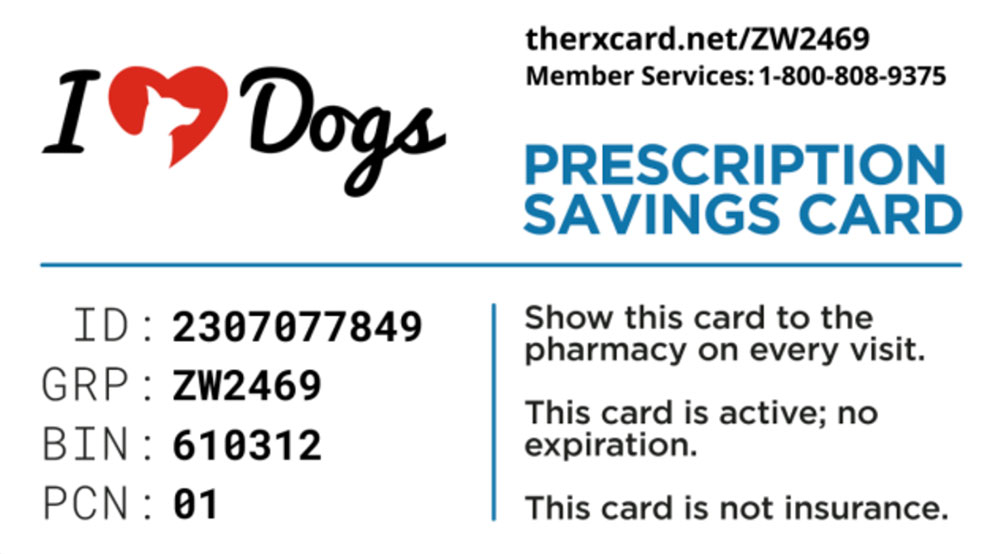Are you looking for a way to save your dog’s Pantoprazole prescription? Our Rx Discount Card for Pets can save you up to 80% of your pet’s Pantoprazole.
What Pharmacies Accept This Pantoprazole Coupon Card for Pets?
This card is accepted at over 60,000 participating pharmacies in the US, including:
How Much Will My Pet’s Pantoprazole Cost Using This Coupon?
In order to view a real-time pricing estimate, please use our pricing lookup tool here.
How Do Prescription Discount Cards for Pets Work? How Can It Help Me Save On My Dog’s Pantoprazole Prescription?
Prescription discount cards for pets are similar to those for humans. They offer discounts on various medications, including prescription drugs that pets may need. Here’s a quick rundown of how they work:
- Sign Up: Many discount cards are free, while others might require a nominal annual or monthly fee. After signing up, you’ll receive a card or a digital copy of it.
- Find a Participating Pharmacy: These discount cards are accepted at a wide range of pharmacies. Check the provider’s website or call them to confirm which pharmacies in your area participate in the program.
- Present the Card: When filling or picking up your pet’s prescription, show the discount card to the pharmacist. The discount will be applied when they ring up your purchase.
- Pay Less: You’ll pay the discounted price instead of the full price of the medication.
A prescription discount card can help you save on your pet’s Pantoprazole prescription by reducing the amount you have to pay out-of-pocket. Keep in mind that savings can vary depending on the specific medication, the card’s discount rate, and the retail price at a specific pharmacy.
A few important things to remember:
- Prescription discount cards are not insurance and don’t combine with pet insurance.
- Discounts are applied to medication costs only, not veterinary consultations or procedures.
- Not all medications may be covered by all cards, and discount rates may vary.
As with any cost-saving strategy, it’s wise to compare prices with and without the card at different pharmacies to ensure you’re getting the best deal. Also, remember to consult with your vet about any concerns regarding your pet’s medication cost. They might be able to suggest other cost-saving strategies or alternative treatments.
What Are Some Common Reasons Pantoprazole is Prescribed for Dogs?

Pantoprazole is a proton pump inhibitor (PPI) that decreases the amount of acid produced in the stomach. In dogs, it is used off-label or extra-label, which means its use in dogs is not explicitly approved by the FDA, but veterinarians legally prescribe it as a part of their medical judgment.
Pantoprazole might be prescribed for dogs for several reasons, such as:
- Gastric ulcers and erosions: Pantoprazole can be used in the treatment of gastric ulcers and erosions by reducing gastric acid production, thus providing a more conducive environment for healing.
- Gastroesophageal reflux disease (GERD): In cases where a dog is diagnosed with GERD, pantoprazole can be used to manage the condition by reducing the acidity of the stomach contents.
- Esophagitis: Pantoprazole may also be used in the treatment of esophagitis, which is inflammation of the esophagus often caused by acid reflux.
- Hypersecretory conditions: These are conditions in which the stomach produces too much acid, such as Zollinger-Ellison syndrome, though these are quite rare in dogs.
It’s important to remember that while Pantoprazole can be effective in managing these conditions, it should only be used under the direction and supervision of a veterinarian. As with any medication, there can be side effects, and it may interact with other medications your dog is taking.
What Are Some Other Ways I Can Save Money on My Pet’s Pantoprazole Prescription?
Certainly! Here are some additional strategies to consider when trying to save money on your pet’s Pantoprazole prescription:
- Price Comparisons: Prices for medications can vary widely from one pharmacy to another. Use online resources or call around to different pharmacies in your area to find the best price.
- Generic Medications: Pantoprazole is actually a generic medication itself. However, the price can still vary from one manufacturer to another, so it’s worth asking your vet or pharmacist if there’s a cheaper version available.
- Online Pharmacies: Sometimes, online pharmacies offer lower prices than brick-and-mortar stores. Just be sure to use a reputable website that requires a prescription.
- Buy in Bulk: If your pet is going to be on Pantoprazole long-term, buying in larger quantities could result in cost savings. Always consult with your vet before changing your purchasing habits to ensure it’s safe and effective for your pet.
- Pharmaceutical Company Programs: Some pharmaceutical companies offer assistance programs or discounts for their products. It’s worth checking to see if any are available for Pantoprazole.
- Pet Insurance: If you have pet insurance, check to see if it covers prescription medications. Some policies do, and this could result in significant cost savings.
- Talk to Your Vet: If cost is a major concern, have an open conversation with your vet. They might have additional suggestions for savings or could potentially prescribe a different, more affordable medication with similar effects.
Always ensure that any changes you make are in the best interest of your pet’s health. Always consult with a veterinarian before making changes to your pet’s medication regimen.


 Toledo, United States.
Toledo, United States.